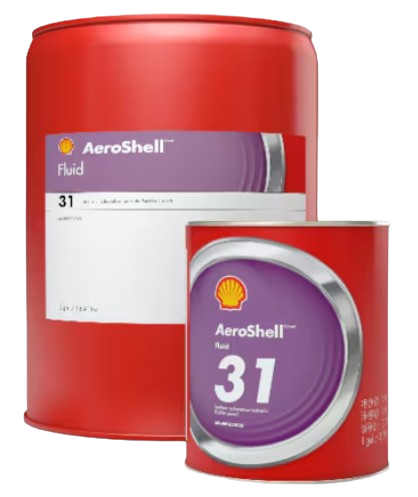AeroShell Fluid 31
AeroShell Fluid 31 is a synthetic hydrocarbon aircraft hydraulic fluid with improved fire resistance, high flash point, coupled with good oxidation and thermal stability.

Features and benefits
Enhanced Fire Resistance
High Oxidation Stability and Corrosion Resistance
Low-Temperature Fluidity
Robust Anti-Wear Protection
Wide Operating Temperature Range
Specifications & approvals
| Country | Specification |
|---|---|
| United States | MIL-PRF-83282D |
| French | DCSEA 437/B |
| NATO Code | H-537 |
| Joint Service Designation | OX-19 |
The TDS and MSDS are in English, but you can find these documents for other countries in the Shell EPC area
.
Applications
AeroShell Fluid 31 is recommended for use in aircraft, ordnance, and missile systems operating from -40°C to +205°C (-40°F to +401°F). This fluid should be considered for use in auto pilots, shock absorbers, brakes, flight control systems, hydraulic servo-controlled systems and other systems using synthetic elastomer seals.
An increasing number of aircraft manufacturers now recommend use of this type of fluid in aircraft hydraulic systems in preference to mineral hydraulic oils. This move has been prompted by the need to use fluids with better fire-resistant properties.
AeroShell Fluid 31 is also approved for use in the Honeywell (formerly Garrett) cooling turbine (cabin air compressors). Increasingly this type of hydraulic fluid is being adopted for use in hydraulic systems of military aircraft in place of mineral hydraulic fluids. AeroShell Fluid 31 is a synthetic hydrocarbon oil and should not be used in contact with incompatible seal materials.
AeroShell Fluid 31 is compatible with AeroShell Fluids 41 and 61 and can be used in systems designed to operate with MIL-PRF-5606, MIL-PRF-6083, MIL-PRF-87257 and MIL-PRF-46170 fluids. Chlorinated solvents should not be used for cleaning hydraulic components which use AeroShell Fluid 31. The residual solvent contaminates the hydraulic fluid and may lead to corrosion.
Health, Safety and Environment
-
Health and Safety
- This product is unlikely to present any significant health or safety hazard when properly used in the recommended application and good standards of personal hygiene are maintained.
- Avoid contact with skin. Use impervious gloves with used oil. After skin contact, wash immediately with soap and water.
- Guidance on Health and Safety is available on the appropriate Safety Data Sheet, which can be obtained from https://www.epc.shell.com
.
Protect the Environment
- Take used oil to an authorised collection point. Do not discharge into drains, soil or water.
Additional information
Advice
- Advice on applications not covered here may be obtained from your Shell representative.
Get in touch with us
We’re here to assist you with any inquiries or support you may need
Typical Physical Characteristics
| Properties | Method | MIL-PRF-83282D | Typical |
|---|---|---|---|
| Oil type | – | Synthetic Hydrocarbon | Synthetic Hydrocarbon |
| Colour | – | – | Red |
| Specific Gravity @15.6/15.6°C | ASTM D1298 | Report | 0.851 |
| Kinematic Viscosity @205°C mm²/s | ASTM D445 | 1.0 min | 1.06 |
| Kinematic Viscosity @100°C mm²/s | ASTM D445 | 3.45 min | 3.53 |
| Kinematic Viscosity @40°C mm²/s | ASTM D445 | 14.0 min | 14.3 |
| Kinematic Viscosity @–40°C mm²/s | ASTM D445 | 2 200 max | 2 059 |
| Pour Point °C | ASTM D97 | -55 max | -69 |
| Flash Point °C | ASTM D92 | 205 min | 218 |
| Fire Point (COC) °C | ASTM D92 | 245 min | 251 |
| Total Acid Number mgKOH/g | ASTM D664 | 0.10 max | 0.02 |
| Evaporation Loss @205°C %m | FED-STD-791 M.350 | 20 max | 10 |
| Low temperature stability 72 hrs @-40°C | FED-STD-791- 3458 | Must pass | Passes |
| Barium content mg/kg | ASTM D5185 | 10 max | 0 |
| Gravimetric analysis mg/100ml | ASTM D4898 | 0.3 max | 0.2 |
| Solid Particle Contamination | FED-STD-791 M.3009 | Must pass | Passes |
| Water Content mg/kg | ASTM D1744 | 100 max | 60 |
| Foaming Characteristics – Seq I Tendency Stability, ml/ml | ASTM D892 | 65/0 | Passes |
| Flame Propagation cm/s | ASTM D5306 | Must pass | Passes |
| 4-Ball Wear, 75°C – scar dia 1 kg load/1200 rpm, mm | ASTM D4172 | 0.21 max | 0.16 |
| 4-Ball Wear, 75°C – scar dia 10 kg load/1200 rpm, mm | ASTM D4172 | 0.30 max | 0.22 |
| 4-Ball Wear, 75°C – scar dia 40 kg load/1200 rpm, mm | ASTM D4172 | 0.65 max | 0.51 |
| Corrosion & oxidation stability 168 hrs @121°C – metal weight change, mg/cm² | ASTM D4636 | Must pass | Passes |
| Corrosion & oxidation stability 168 hrs @121°C – viscosity change, % | ASTM D4636 | 10 max | <10 |
| Corrosion & oxidation stability 168 hrs @121°C – acid number change, mgKOH/g | ASTM D4636 | 0.2 max | <0.02 |



